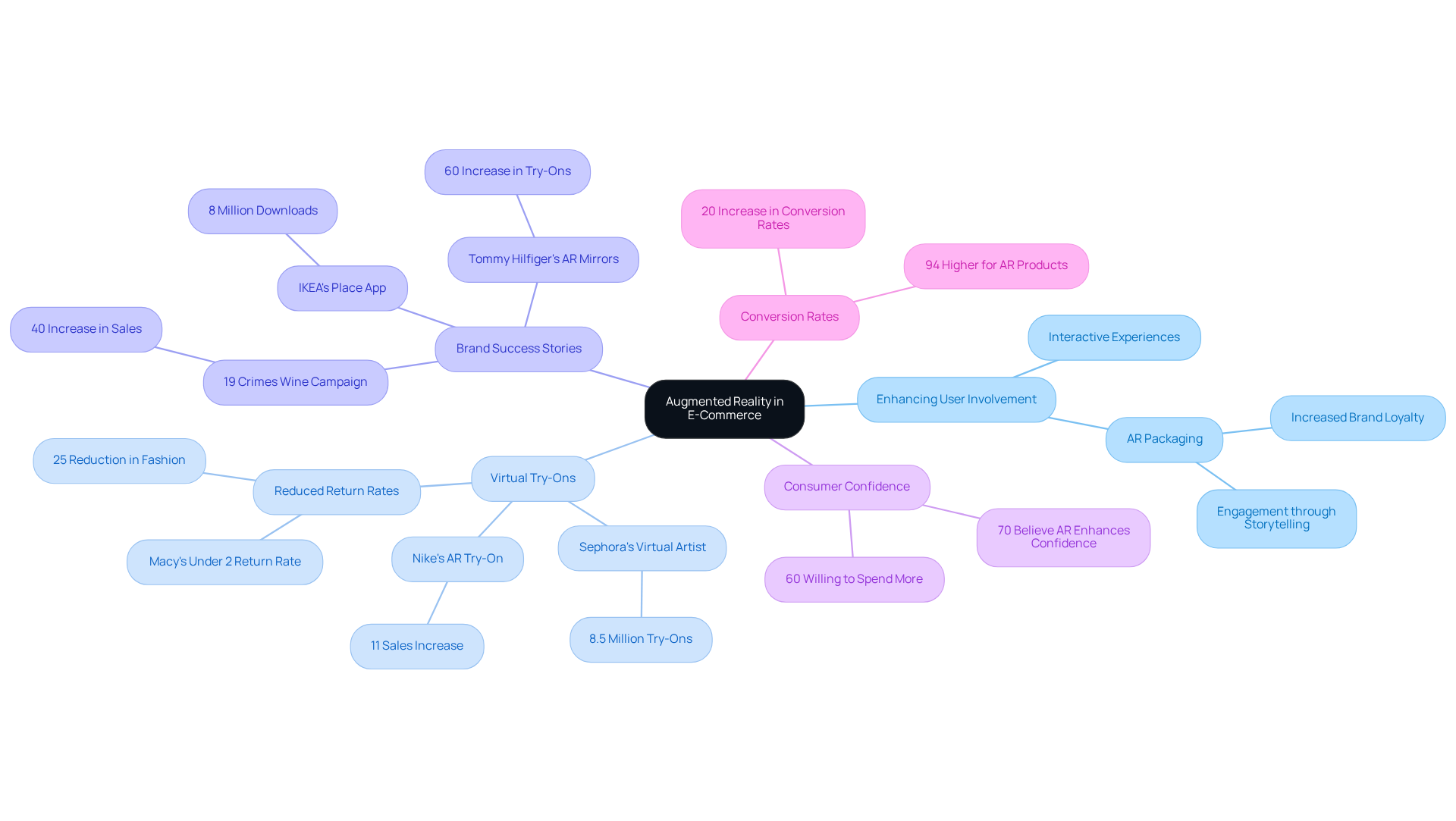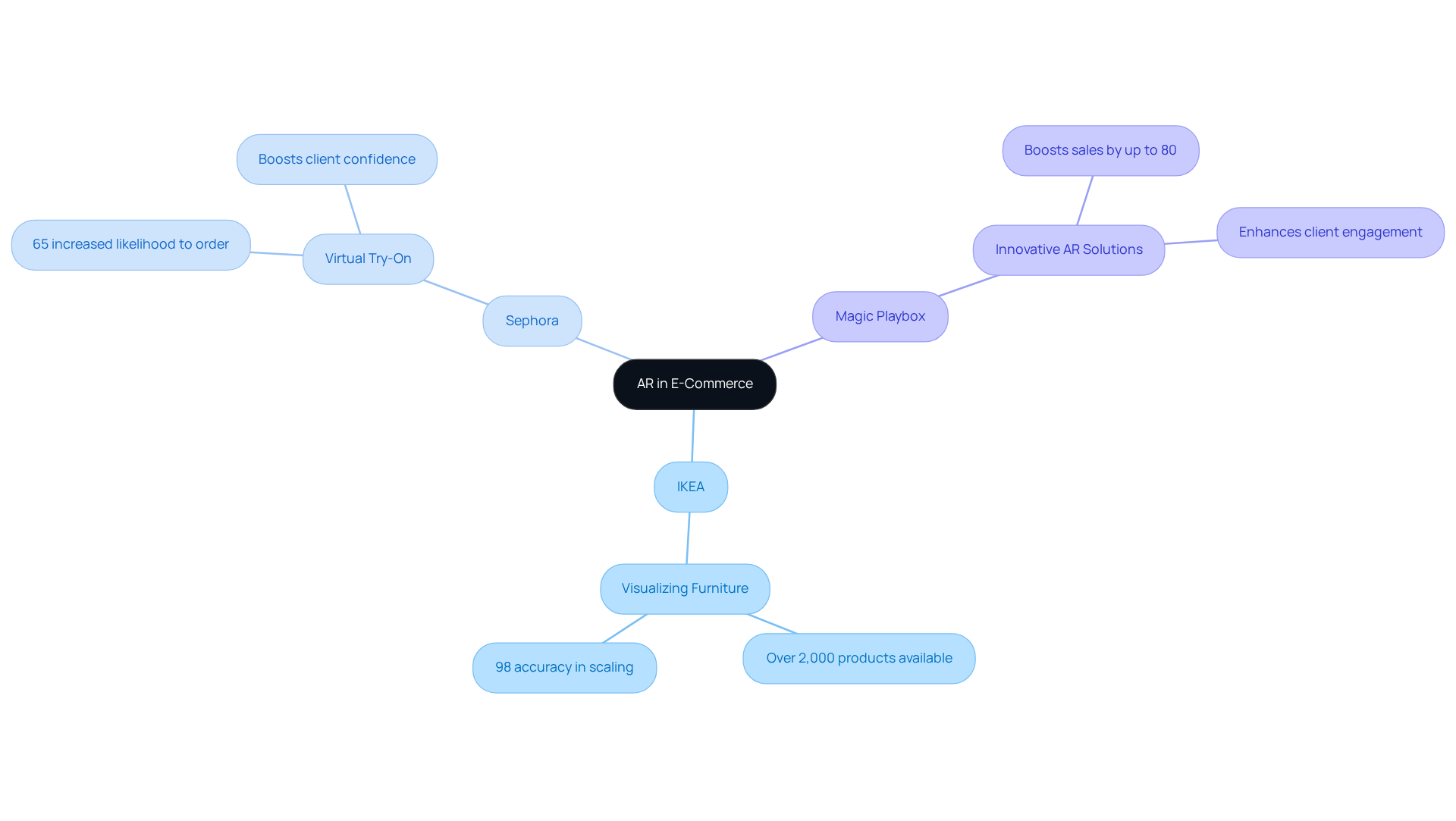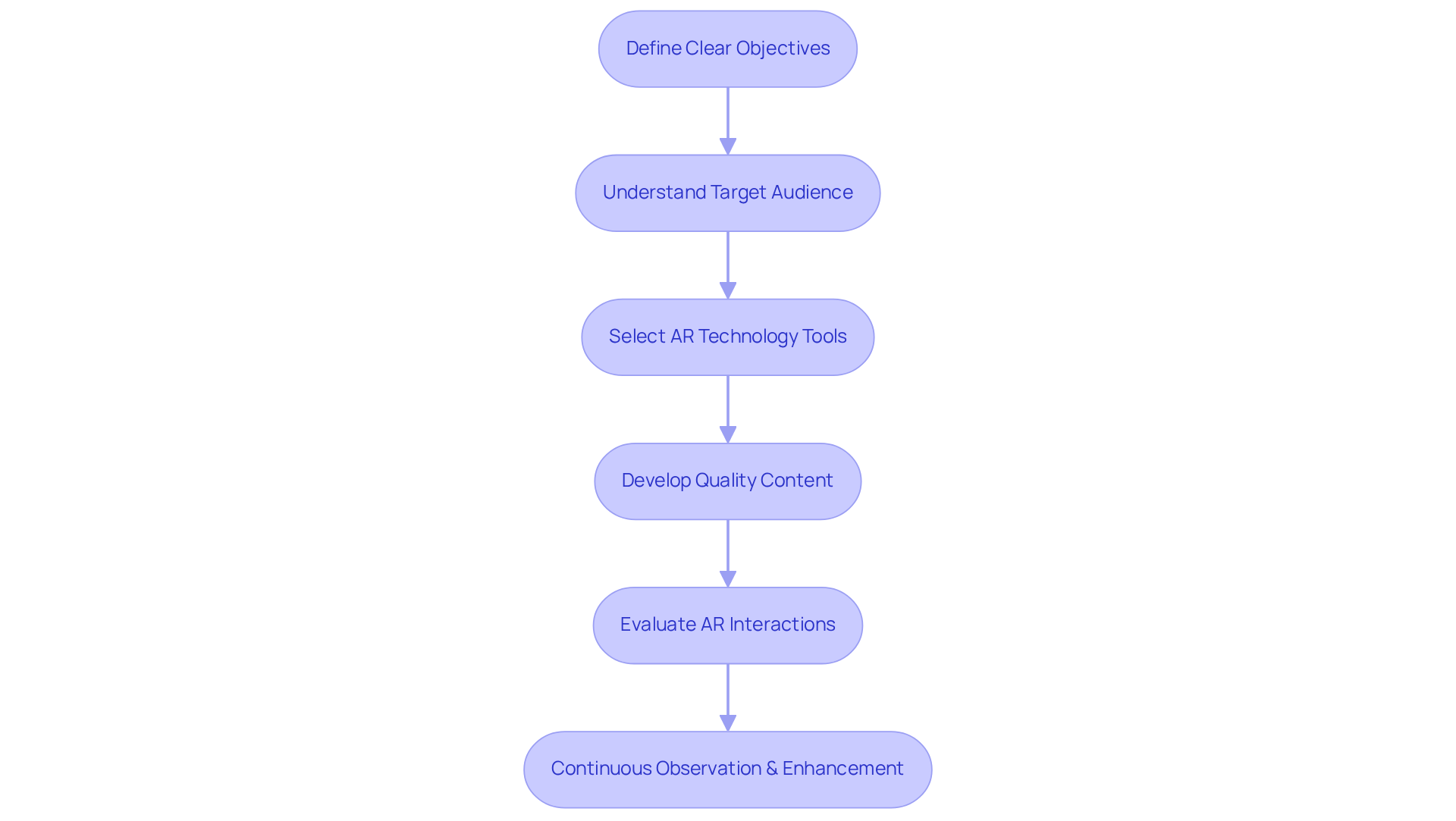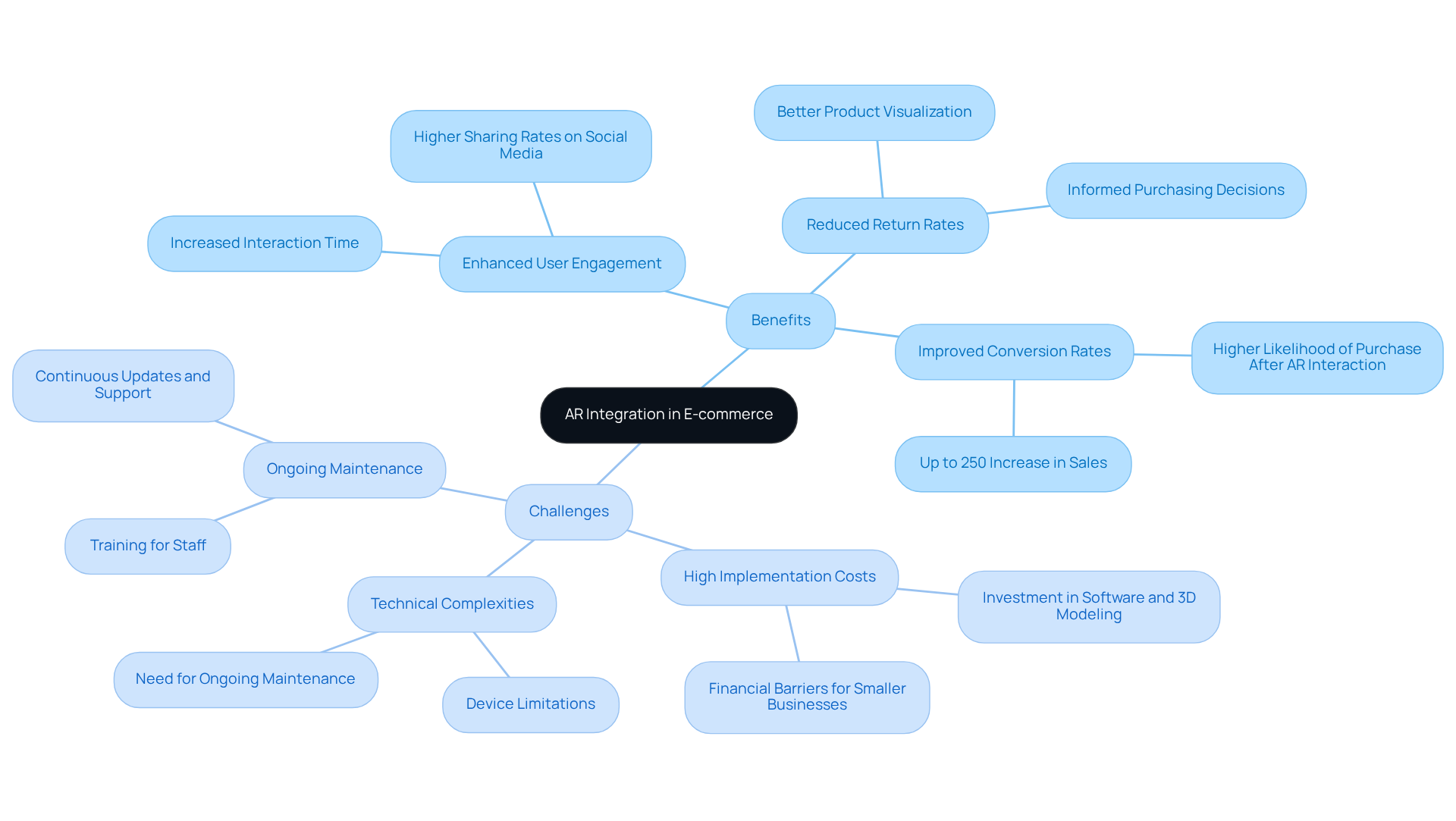Overview
This article presents four strategic approaches to harnessing augmented reality (AR) technology within the e-commerce sector, highlighting its remarkable potential to amplify customer engagement, elevate conversion rates, and diminish return rates. Notably, successful implementations from esteemed brands such as Sephora and IKEA exemplify how AR empowers consumers to visualize products in their own environments. This capability fosters increased confidence in purchasing decisions, ultimately driving sales. Embrace these proven strategies to position your brand at the forefront of the AR revolution in e-commerce.
Introduction
Augmented reality technology is revolutionizing the e-commerce landscape by seamlessly merging the digital and physical worlds, thereby offering consumers a profoundly immersive shopping experience. By empowering users to visualize products within their own environments, AR significantly enhances engagement and bolsters buyer confidence. This, in turn, leads to increased conversion rates and reduced return rates.
However, as brands eagerly adopt this cutting-edge technology, they encounter the challenge of effectively integrating AR into their existing operations.
What proven strategies can e-commerce businesses implement to leverage augmented reality and truly transform the online shopping experience?
Understand Augmented Reality and Its Impact on E-Commerce
Augmented reality technology is revolutionizing e-commerce by superimposing digital information onto the physical world, thereby creating engaging interactions that significantly enhance user involvement. This transformative augmented reality technology empowers clients to visualize products within their own environments, fundamentally altering the shopping experience.
For example, AR enables virtual try-ons for apparel and accessories, allowing individuals to see how items would appear on them before making a purchase. This capability not only bolsters buyer confidence but also leads to a notable reduction in return rates, as shoppers are more likely to be satisfied with their selections.
Research indicates that augmented reality technology can drive a 20% increase in conversion rates, establishing it as an essential resource for e-commerce brands aiming to innovate and effectively engage their audience. Brands like Sephora and Nike have successfully integrated AR, with Sephora's Virtual Artist app recording over 8.5 million try-ons, significantly enhancing consumer confidence in online makeup purchases.
Additionally, Magic Playbox has made impressive advancements in this domain, offering tailored AR solutions that elevate customer engagement and satisfaction. Furthermore, research shows that 70% of consumers believe that the ability to test items using AR enhances their confidence in online shopping, while 60% are willing to spend more with brands that provide interactive experiences.
As augmented reality technology continues to advance, incorporating it into e-commerce strategies will be vital for brands striving to remain competitive and meet the expectations of today's digitally savvy consumers. Moreover, products featuring 3D/AR content experience an average of 94% higher conversion rates than those without it, underscoring the effectiveness of AR in driving sales.

Explore Effective Use Cases of AR in E-Commerce
Numerous brands have effectively harnessed augmented reality technology to transform their e-commerce strategies. A prime example is IKEA's Place app, which enables users to visualize how furniture will fit and appear in their homes before making a purchase. This groundbreaking tool features over 2,000 items and employs ARKit technology for precise scaling, significantly enhancing the shopping process and influencing buying choices.
In the beauty industry, brands such as Sephora have embraced virtual try-on features, allowing individuals to see how makeup items will look on their skin. This engaging interaction not only boosts client confidence but also results in a remarkable 65% increase in the likelihood of placing an order after engaging with AR content.
These successful implementations demonstrate how AR enhances visualization of items, leading to increased satisfaction among clients and reduced return rates. Research indicates that AR shopping experiences can decrease returns by 25% to 40%, showcasing the technology's potential to foster deeper connections between consumers and brands. Furthermore, AR enables interactive demonstrations of items, allowing clients to engage with offerings in a more meaningful way, ultimately driving loyalty and sales.
Magic Playbox also plays a pivotal role in this landscape, providing innovative AR solutions that enhance client engagement and loyalty. By integrating Magic Playbox's innovations and utilizing augmented reality technology, brands can craft immersive experiences that not only showcase products effectively but also resonate with consumers on a deeper level, further boosting sales and minimizing return rates.

Implement AR Technology Strategically in Your E-Commerce Operations
To implement augmented reality technology solutions effectively, businesses must first define clear objectives, such as enhancing customer engagement or minimizing return rates. Understanding the target audience is crucial; research indicates that two in three consumers express interest in using augmented reality technology for shopping, which underscores the potential for increased interaction.
Selecting the appropriate augmented reality technology tools is vital, with options that include mobile applications and web-based solutions. Once the augmented reality technology is selected, businesses should prioritize developing high-quality content that resonates with their brand identity.
Evaluating AR interactions with a chosen user group can yield important insights, ensuring the final product meets client expectations. Continuous observation and enhancement of augmented reality technology features are essential for maintaining relevance and effectiveness in improving user experience, as augmented reality technology applications can boost sales by up to 80% when implemented effectively.

Evaluate Benefits and Overcome Challenges of AR Integration
Incorporating augmented reality technology into e-commerce presents significant advantages, including enhanced user engagement, improved conversion rates, and reduced return rates. However, e-commerce brands frequently face challenges such as high implementation costs, technical complexities, and the need for ongoing maintenance. For instance, developing AR applications can pose a financial barrier for smaller businesses, necessitating substantial investments in software and 3D modeling.
To effectively navigate these hurdles, companies should consider initiating pilot projects that test AR features on a smaller scale. This approach allows for the assessment of effectiveness without incurring substantial upfront costs. Collaborating with AR specialists can further streamline the development process, ensuring the creation of high-quality content and effective integration. Brands like Sephora exemplify successful AR implementation through their Virtual Artist app, which facilitated over 200 million makeup shade trials, showcasing how AR can enhance customer interaction while minimizing return rates.
Moreover, leveraging WebAR capabilities enables consumers to access AR interactions via mobile browsers without the need for app downloads, thereby expanding reach and involvement. This strategy has led to campaigns achieving 2-3 times more user engagement compared to traditional app-based experiences. By proactively addressing these challenges and employing innovative strategies, businesses can fully harness the transformative potential of AR technology in their e-commerce operations.

Conclusion
Augmented reality technology is fundamentally reshaping the landscape of e-commerce by creating immersive experiences that enhance consumer interactions with products. By enabling shoppers to visualize items in their own environments, AR not only boosts confidence in purchasing decisions but also significantly reduces return rates. This makes it an essential tool for brands striving to thrive in a competitive market.
The article highlights several key strategies for leveraging AR in e-commerce, showcasing successful case studies from brands like IKEA and Sephora. These brands have effectively utilized AR to improve customer engagement and satisfaction. It emphasizes the importance of strategic implementation, from defining clear objectives to continuously evaluating user interactions, ensuring that AR solutions meet consumer expectations and drive sales. Moreover, the potential benefits of AR, such as increased conversion rates and reduced returns, are underscored, alongside the challenges brands may face in adopting this technology.
As the digital shopping experience evolves, embracing augmented reality will be crucial for brands aiming to connect with today’s tech-savvy consumers. By prioritizing innovative AR solutions and addressing implementation challenges, e-commerce businesses can enhance customer interactions and position themselves at the forefront of retail innovation. The time to explore and integrate augmented reality is now, as it holds the key to unlocking new levels of engagement and satisfaction in the online shopping experience.
Frequently Asked Questions
What is augmented reality (AR) and how does it impact e-commerce?
Augmented reality (AR) technology superimposes digital information onto the physical world, creating engaging interactions that enhance user involvement in e-commerce. It allows clients to visualize products in their own environments, transforming the shopping experience.
How does AR improve the online shopping experience?
AR improves the online shopping experience by enabling virtual try-ons for apparel and accessories, allowing users to see how items would look on them before purchasing. This boosts buyer confidence and reduces return rates.
What are the benefits of using AR in e-commerce?
The benefits of using AR in e-commerce include a potential 20% increase in conversion rates, enhanced consumer confidence, and reduced return rates. Additionally, products with 3D/AR content can see an average of 94% higher conversion rates than those without it.
Which brands have successfully integrated AR into their e-commerce strategies?
Brands like Sephora and Nike have successfully integrated AR into their e-commerce strategies. For instance, Sephora's Virtual Artist app has recorded over 8.5 million try-ons, significantly boosting consumer confidence in online makeup purchases.
What do consumers think about AR in online shopping?
Research indicates that 70% of consumers believe that the ability to test items using AR enhances their confidence in online shopping, while 60% are willing to spend more with brands that offer interactive experiences.
Why is incorporating AR into e-commerce strategies important for brands?
Incorporating AR into e-commerce strategies is vital for brands to remain competitive and meet the expectations of today's digitally savvy consumers, as it enhances customer engagement and satisfaction.




